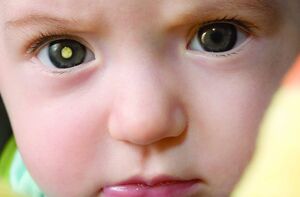Retinoblastoma
Retinoblastoma is a malignant tumor of the retina. It usually manifests in the first 3 years of life. Almost a third of cases are bilateral.
Etiopathogenesis[edit | edit source]
It usually arises unilaterally, usually as a result of somatic mutation of both copies of the RB1 gene (the so-called retinoblastoma gene, localization: 13q14.1-q14.2). In about 50% of cases, one mutated allele of the RB1 gene is inherited and the second mutation occurs during life (germline + somatic mutation). Thus, although mutations in RB1 are recessive (both copies must be affected for disease manifestation), the predisposition (germline mutations) is inherited with autosomal dominant inheritance with high penetrance.
Two-thirds of retinoblastomas are diagnosed in the first 3 years of life, with a peak incidence in the first and second years of life. After the sixth year of life, it occurs only very rarely. About 20-30% of children have bilateral tumors at the time of diagnosis.
Clinical picture[edit | edit source]
- gradual loss of visual acuity in one eye and development of squint
- parents often notice a change from a light glare in the eye to a whitish glare
- Leukocoria
- enlargement of the eye, redness and swelling around the eye
- signs of brain and spinal cord involvement
Diagnostics[edit | edit source]
Eye examination (in young children under general anaesthesia) - typical finding, diagnosis unambiguous.
- ophthalmoscopy - grey-white nodule on the retina, it is a late stage when the tumour fills the vitreous cavity
Examination of both eyes, NMR of the brain and spinal cord, cerebrospinal fluid examination are performed to determine the extent
Terapy[edit | edit source]
- chemotherapy and local therapy (cryotherapy, intraocular administration of cytostatics)
- enucleation of the eye and replacement with a prosthesis (for unilateral disability - the eye is usually already blind, this is a life-saving procedure)
- radiotherapy (brachytherapy, external photon radiotherapy, proton therapy)
Complications[edit | edit source]
A common complication is secondary glaucoma. A higher risk of subsequent (secondary) tumours is found in children with genetic disease (RB1 gene), e.g. osteosarcoma
Prognosis[edit | edit source]
Prognosis depends on the timeliness of diagnosis. If the retinoblastoma is only inside the eye at the time of diagnosis, the success rate of treatment is 90-100%. If the retinoblastoma already extends outside the eye the chance of survival is about 10%.
Links[edit | edit source]
References[edit | edit source]
- BENEŠ, Jiří. Otázky z očního lékařství [online]. [cit. 2010-12-14]. <http://jirben2.chytrak.cz/>.
- ↑ Skočit nahoru k:a b c d e f Klinika dětské onkologie FN Brno. Retinoblastom [online]. [cit. 2011-01-02]. <https://www.fnbrno.cz/detska-nemocnice/klinika-detske-onkologie/informace-pro-pacienty/t2698>.
Used literature[edit | edit source]
- ROZSÍVAL, Pavel, et al. Oční lékařství. 1. vydání. Galén, Karolinum, 2006. ISBN 80-7262-404-0.
- KOLÍN, Jan. Oční lékařství. 2. vydání. Karolinum, 2007. ISBN 978-80-246-1325-3.

